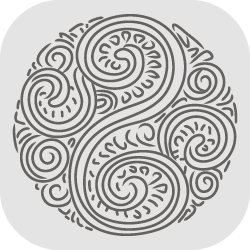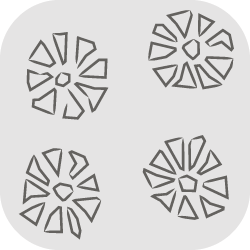- Object Date
- Goryeo 고려 高麗 dynasty (918–1392), mid-fourteenth century
- Medium
- Hanging scroll; ink, color, and gold on silk
- Dimensions
- Image: 130.2 x 81.9 cm (51 1/4 x 32 1/4 in.)
Overall: 244 x 102 cm (96 1/16 x 40 3/16 in.)
- Credit Line
- Gift of Professor Harold Gould Henderson
- Collection
- Brooklyn Museum
- Accession Number
- 61.204.30
- Provenance
To 1938
Possibly G. Kitanaka 北中, KyotoFrom 1938 to 1961
Professor Harold Gould Henderson (1889–1974) purchased the painting in Japan and sent it to the Brooklyn Museum; he donated it to the Museum on December 13, 1961From 1961
Brooklyn Museum
- Previous Owners
The donor, Harold Gould Henderson (1889–1974), was a curator at the Metropolitan Museum of Art (1927–1929), professor at Columbia University (1934–1956, interrupted by service in World War II), and President of the Japan Society (1948–1952).
- Apparatus
- Arrived in a wooden box with inscriptions on the lid: “Amitabha triad 彌陀三尊像, painted by Zhang Sigong 張思恭筆” in Chinese characters. Sticker stating “Di si hao 第四号 [Number 4]” with seal impression tentatively identified as a Japanese auction house’s mark; another Japanese sticker from Kyoto-based art dealer “G. Kitanaka 北中” states “Chinese, Sung [Song] 宋, attributed to Cho Shikyo [Ch. Zhang Sigong 張思恭].” Additional accession related information cut into surface of soft wood box: “38.1 A+B Henderson.”
- Remarks
(Brooklyn Museum gift list, June 28, 1961) 15. Buddha and bodhisattvas. China, Late Sung [Song] 宋 – Yuan 元, ca. 1300.
(Mr. Chozo Yamanouchi 山内長三, specialist on late Nanga 南画 painting from Tokyo, February 10, 1974) This painting was actually by a Korean artist and is of late Koryo [Goryeo] 고려 高麗 date.
(Youngsook Pak 박영숙, specialist on Korean Buddhist painting at Heidelberg University, June 24, 1978) Re-identified the subject of this painting as “Amida raigo 阿彌陀來迎 (Kr. Amita naeyeong 아미타내영; Descent of Buddha Amitabha)” painted in Korea, Koryo [Goryeo] 고려 高麗 dynasty, based on stylistic details.
(Undated catalogue card) The attribution of this painting to the Koryo [Goryeo] 고려 高麗 period (fourteenth century) is further demonstrated by two comparable scrolls of the subject “Amida nyorai 阿彌陀如來 (Kr. Amita yeorae 아미타여래; Buddha Amitabha)” exhibited at the Nara Museum 奈良國立博物館, 1978, and published and illustrated in Nara kokuritsu hakubutsukan. Nihon Bukkyo bijutsu no genryu [Sources of Japanese Buddhist Art]. Nara: The Museum, 1978, cat. no. 34 (Atami Museum collection, Shizuoka prefecture) and no. 36 (private collection, Tokyo).
(K. Shirts, February 13, 2008 per Korean Art Collection in the Brooklyn Museum [New York, NY, 2006]) Dynasty changed from “Koryo” to “Goryeo.”
- Published References
Saldern, Axel von. The Brooklyn Museum Handbook. Brooklyn, NY: Brooklyn Museum, 1967. 150–51.
Moes, Robert J. Korean Art from the Brooklyn Museum Collection. New York: Universe Books, 1987. 48–49, pl. 11.
Pak Young-sook 박영숙. “Amitabha Triad: A Koryo Painting in the Brooklyn Museum.” In Sambul Gim Won-lyong gyosu jeongnyeon toeim ginyeom nonchong II 三佛 金元龍敎授 停年退任紀念論叢 II [Festschrift for Professor Kim Won-yong, Korean Art and Archaeology, vol. II]. Seoul: Iljisa, 1987. 513–36.
Chung Woothak 鄭于澤. “Kōrai jidai no Amida sanzon zu 高麗時代の阿弥陀三尊図 [The Painting of Amitabha Triad in the Koryo Period].” Sen-oku Hakkokan kiyō 泉屋博古館紀要 5, (1988): 57, fig. 4.
Hanguk Gukje Gyoryu Jaedan 한국국제교류재단. Miguk bangmulgwan sojang Hanguk munhwajae 미국박물관 소장 한국문화재 [Korean Relics in the United States]. Seoul: Hanguk Gukje Munhwa Hyeopoe, 1989. 82, pl. 6.
Kim, Hongnam. The Story of a Painting: A Korean Buddhist Treasure from the Mary and Jackson Burke Foundation. New York: Asia Society Gallery, 1991. No. 8.
Chung Woothak 鄭于澤. “Goryeo bulhwa e isseoseo dosang ui jeonseung 高麗佛畫에 있어서 圖像의 傳承 [Transmission of the Iconography in Buddhist Paintings of the Goryeo Period].” Misulsahak yeongu 美術史學硏究 192 (1991): 13–15, pl. 27.
Moon Myung-dae. “Buddhist Painting from the Koryo Period.” Koreana 6, no. 3 (1992): 14–19, pl. 15.
Turner, Jane S. The Dictionary of Art, Vol 18. New York: Grove, 1996. 305, fig. 35.
Kikutake Junichi 菊竹淳一 and Chung Woothak 鄭于澤, eds. Goryeo sidae ui bulhwa 高麗時代의 佛畵 [The Buddhist paintings of Koryo dynasty]. Seoul: Sigongsa, 1997. Vol. 1: 85, pl. 36; Vol. 2: 73.
Woo Hyunsoo 우현수. “Brooklyn misulgwan e sumswineun Hanguk mi ui sumgyeol 브루클린미술관에 숨쉬는 한국 미의 숨결 [Korean art collection of the Brooklyn Museum of Art].” Wolgan misul 월간미술 2, no. 1 (1999): 120.
Kikutake Junichi 菊竹淳一 and Chung Woothak 鄭于澤, eds. Kōrai jidai no butsuga 高麗時代の仏画
[The Buddhist paintings of Koryo Dynasty]. Seoul: Sigongsa, 2000. 85, 427, pl. 36.Poster, Amy. Journey Through Asia: Masterpieces of Asian Art in the Brooklyn Museum of Art. Brooklyn, NY and London: Brooklyn Museum of Art and Phillip Wilson Publishers, 2003. 138–9, pl. 50.
Gungnip Munhwajae Yeonguso 국립문화재연구소. Miguk Beurukeullin bangmulgwan sojang Hanguk munhwajae 미국 브루클린박물관 소장 한국문화재 [Korean Art Collection in the Brooklyn Museum, New York, USA]. Daejeon: Gungnip Munhwajae Yeonguso, 2006. 119, 241, pl. 180.
Chung Woothak 정우택. “Miguk sojae Hanguk bulhwa josa yeongu 미국소재 한국불화 조사 연구 [Investigation Research on the Korean Buddhist Painting in the United States].” Dongak misulsahak 東岳美術史學 13 (2012): 37, fig. 4.
- Restrictions & Rights
- Copyright with museum























